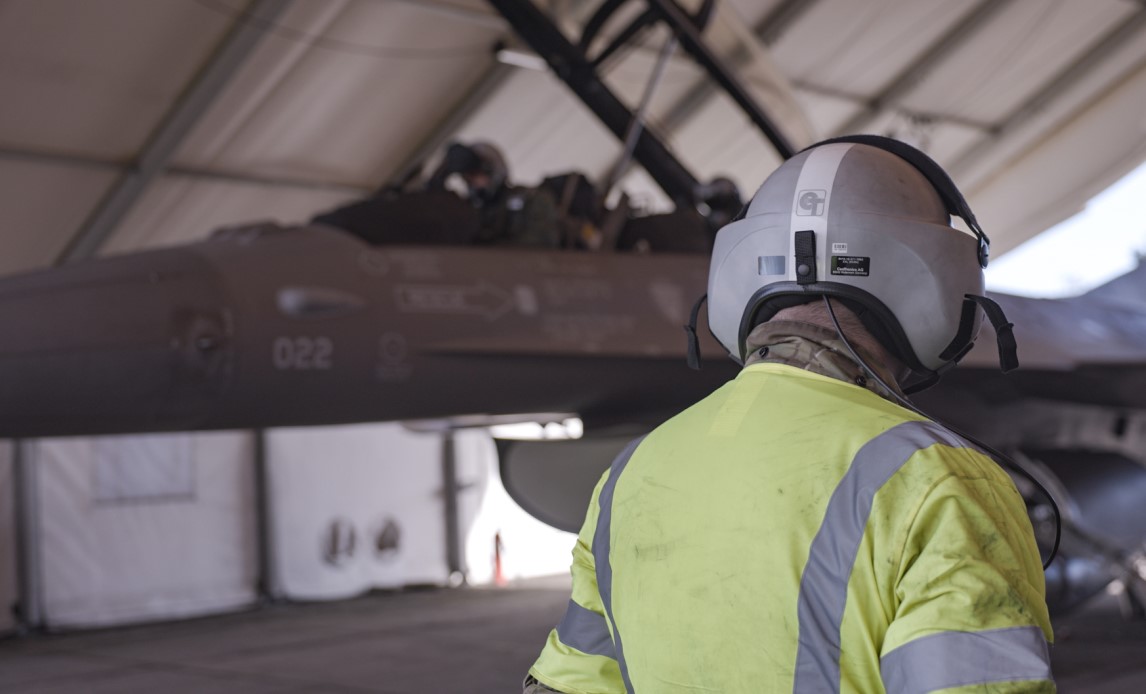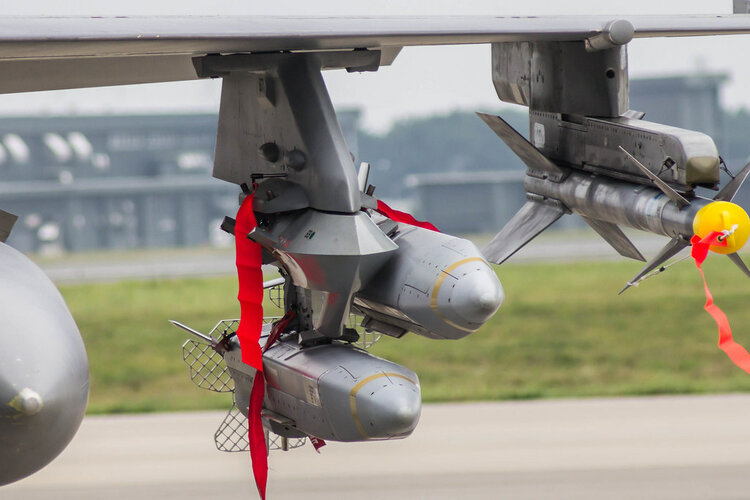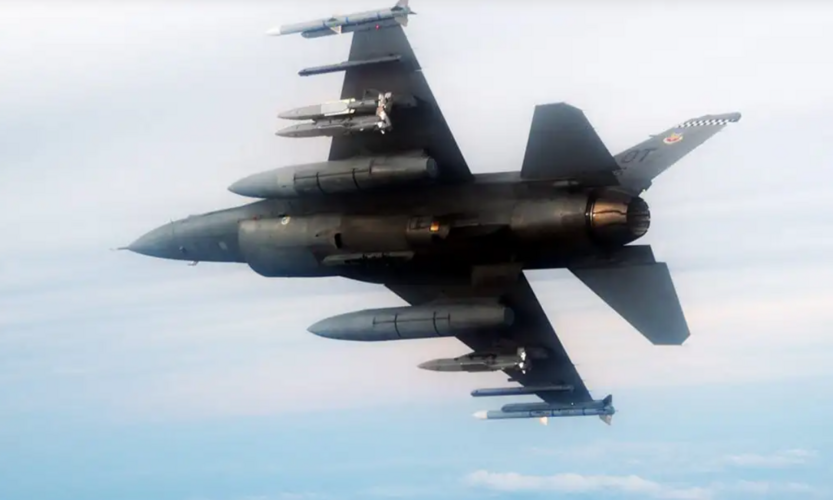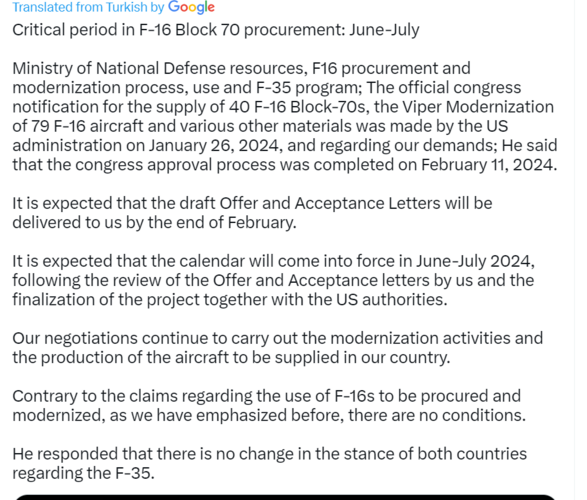You are using an out of date browser. It may not display this or other websites correctly.
You should upgrade or use an alternative browser.
You should upgrade or use an alternative browser.
Lockheed Martin F-16 Fighting Falcon Developments
- Thread starter seruriermarshal
- Start date
- Joined
- 3 June 2011
- Messages
- 17,332
- Reaction score
- 9,069
I remember going up to Hill AFB as a kid when they had an open house specifically to show off their new plane. It did the shortest takeoff I've ever seen an F-16 do and went straight up into the air. Quite a difference from the resident F-4s and F-105s.1978: Delivering the first production F-16 aircraft:

Türkiye – F-16 Aircraft Acquisition and Modernization
Snip.
You might want to edit that post as it's basically a wall of text.
Forest Green
ACCESS: Above Top Secret
- Joined
- 11 June 2019
- Messages
- 5,093
- Reaction score
- 6,674
That red thing is ACMI podF-16, AMRAAM, AIM-9X(?)
F.L.
ACCESS: Top Secret
It looks like a bad photoshop. Notably the roundel and flag on the guy's jacket.
snne
ACCESS: Top Secret
- Joined
- 3 July 2022
- Messages
- 576
- Reaction score
- 1,545
- Joined
- 21 January 2015
- Messages
- 10,684
- Reaction score
- 12,344
The Tweet comes up as not found now.
F-16 fighter with Ukrainian Air Force markings?
General consensus seems to be that the markings are photoshopped. Still, I wonder what the origin of this F-16 is?
General consensus seems to be that the markings are photoshopped. Still, I wonder what the origin of this F-16 is?
- Joined
- 3 June 2006
- Messages
- 2,842
- Reaction score
- 2,544
The
IMHO and IIRC, the original picture shows a F-16 and a pilot from the Royal Danish Air Force.F-16 fighter with Ukrainian Air Force markings?
General consensus seems to be that the markings are photoshopped. Still, I wonder what the origin of this F-16 is?
snne
ACCESS: Top Secret
- Joined
- 3 July 2022
- Messages
- 576
- Reaction score
- 1,545
TAI received DOA and POA certificates by completing EASA's Part 21 regulations for its Özgür project. It is underlined again that 35 aircraft within the scope of the project will be delivered to the Air Force Command.
https://www.tusas.com/medya-merkezi/Dergi?s=1&d=2024#3711

https://www.tusas.com/medya-merkezi/Dergi?s=1&d=2024#3711
aonestudio
I really should change my personal text
- Joined
- 11 March 2018
- Messages
- 2,546
- Reaction score
- 5,969
BlackBat242
OK, I changed my personal text ;)
- Joined
- 10 April 2013
- Messages
- 776
- Reaction score
- 1,903
Block 70 is a single seat "F-16V".
Block 72 is a two seat "F-16V".
Block 70 is a single seat "F-16V".
Block 72 is a two seat "F-16V".
Shouldn't the two-seater be called the F-16W? Just as the two-seat F-16A was called the F-16B, the two-seat F-16C the F-16D and so on.
BLACK_MAMBA
ACCESS: Secret
- Joined
- 17 July 2019
- Messages
- 341
- Reaction score
- 757
It used to be that Block X0 and X2 refered to either a GE or PW engine being used?Block 70 is a single seat "F-16V".
Block 72 is a two seat "F-16V".
BlackBat242
OK, I changed my personal text ;)
- Joined
- 10 April 2013
- Messages
- 776
- Reaction score
- 1,903
Shouldn't the two-seater be called the F-16W? Just as the two-seat F-16A was called the F-16B, the two-seat F-16C the F-16D and so on.
Just going by what I see in print.
It used to be that Block X0 and X2 refered to either a GE or PW engine being used?
Just going by what I see in print.
BLACK_MAMBA
ACCESS: Secret
- Joined
- 17 July 2019
- Messages
- 341
- Reaction score
- 757
"The two variants are identical, except that the Block 70 is powered by a General Electric F110-GE-129 turbofan, while the Block 72 uses a Pratt and Whitney F100-PW-229."Just going by what I see in print.
https://www.timesaerospace.aero/fea...wo variants are identical,Whitney F100-PW-229.
BlackBat242
OK, I changed my personal text ;)
- Joined
- 10 April 2013
- Messages
- 776
- Reaction score
- 1,903
OK, that does better fit the existing naming conventions.
That article also refers to the aircraft as an "F-16D Block 70, a new-build equivalent to the upgraded F-16V", whereas what I had been seeing labeled all block 70/72s as F-16Vs.
As the Block 60s for UAE had been designated F-16E/F, it did not seem correct for the Block 70s to revert to the earlier type designation... especially with other Block 70s carrying the -V designation, but apparently they did.
What I saw (https://www.f-16.net/f-16-news-article5089.html) said
So does anyone have something official from LM, the US government, or the Bahrain government (not the media) as to how these are designated?
That article also refers to the aircraft as an "F-16D Block 70, a new-build equivalent to the upgraded F-16V", whereas what I had been seeing labeled all block 70/72s as F-16Vs.
As the Block 60s for UAE had been designated F-16E/F, it did not seem correct for the Block 70s to revert to the earlier type designation... especially with other Block 70s carrying the -V designation, but apparently they did.
What I saw (https://www.f-16.net/f-16-news-article5089.html) said
which contradicts your reference.In September 2017, the US State Department approved a Foreign Military Sale to Bahrain for 19 new-build F-16V and upgrade its 20 existing F-16C/D Block 40 to F-16V standard.
In June 2018, Bahrain finalized its order for 16 new-build F-16V.
So does anyone have something official from LM, the US government, or the Bahrain government (not the media) as to how these are designated?
"F-16V" seems to be a Lockheed Martin thing, for example this article from 2016: Meet the F-16V: The Most Technologically Advanced 4th Generation Fighter in the World
If we look at Bahrain, for example, in 2017 we see that they are obtaining the F-16V via FMS: Bahrain to buy 19 new F-16Vs and upgrade 20 current Block 40s
FMS aircraft are usually assigned a US military serial number. These aircraft for Bahrain were assigned FY18 serial numbers as follows:
(from Joe Baugher's serial number lists)
I'm not sure where to look up serial numbers otherwise, but if that is accurate, then the official US military designation is still F-16C and F-16D for these aircraft.
If we look at Bahrain, for example, in 2017 we see that they are obtaining the F-16V via FMS: Bahrain to buy 19 new F-16Vs and upgrade 20 current Block 40s
FMS aircraft are usually assigned a US military serial number. These aircraft for Bahrain were assigned FY18 serial numbers as follows:
18-0001/0010 Lockheed Martin F-16C Block 70
MSN 1601-1610. FMS for Royal Bahraini Air Force
18-0011/0016 Lockheed Martin F-16D Block 70
MSN 1611/1616. FMS for Royal Bahraini Air Force
(from Joe Baugher's serial number lists)
I'm not sure where to look up serial numbers otherwise, but if that is accurate, then the official US military designation is still F-16C and F-16D for these aircraft.
snne
ACCESS: Top Secret
- Joined
- 3 July 2022
- Messages
- 576
- Reaction score
- 1,545
perttime
I really did change my personal text
- Joined
- 30 March 2013
- Messages
- 271
- Reaction score
- 233
F-16.net is calling Block 70/72:
"F-16C/D
Block 70/72 (a.k.a. F-16V)"
"F-16C/D
Block 70/72 (a.k.a. F-16V)"
F.L.
ACCESS: Top Secret
Are the twin-seat F-16 scheduled to be delivered to Ukraine are "fully-combat-able" ?
Are the twin-seat F-16 scheduled to be delivered to Ukraine are "fully-combat-able" ?
The twin-seat F-16s are fully combat capable (Otherwise they'd be called TF-16s).
Colonial-Marine
UAVs are now friend, drones are the real enemy.
- Joined
- 5 October 2009
- Messages
- 1,197
- Reaction score
- 707
This is true of the F-16B and F-16D but I believe some later F-16Ds and newer two-seaters are "missionized" in the sense that the guy in back can perform numerous different roles if required. These would be the models with the dorsal "spine" on the back for carrying additional avionics. On the "normal" two-seaters that rear seat is typically just for an instuctor pilot and has only a rather basic set of controls. When those ones are used in combat I'm sure the back seat would be empty.The twin-seat F-16s are fully combat capable (Otherwise they'd be called TF-16s).
aonestudio
I really should change my personal text
- Joined
- 11 March 2018
- Messages
- 2,546
- Reaction score
- 5,969

Træning af ukrainske F-16 personel i fuld gang
Siden efteråret 2023 har specialister fra Forsvaret undervist ukrainske teknikere og piloter i Danmark. Planen er, at de skal blive klar til at modtage og bruge de F-16 kampfly, som Ukraine får doneret i løbet af 2024 og som skal styrke deres forsvarskamp mod Rusland.
 www.forsvaret.dk
www.forsvaret.dk
View: https://twitter.com/bayraktar_1love/status/1760961474791399461?t=wZ3KP4lqXQBzNrJCO7HfhA&s=19
Last edited:
snne
ACCESS: Top Secret
- Joined
- 3 July 2022
- Messages
- 576
- Reaction score
- 1,545
How many were they getting again?? I reckon they will primarily act as "airborne ads", i.e. shoot down cruise missiles and whatnot. They do not pose a credible threat against modernized Flankers(Su-30/34/35S).
- Joined
- 6 November 2010
- Messages
- 4,228
- Reaction score
- 3,166
The ex-Dutch F-16s can carry AMRAAM, IRIS-T, AIM-9X. LANTIRN, TFR, ECM-pods, Litening, FLIR. AN/APG-66v2 radar. They should be quite a handful to take on. The ex-Danish F-16s can at least handle AMRAAM and AIM-9X - https://www.secretprojects.co.uk/th...-21-growler-tabm-sam.2985/page-10#post-635818They do not pose a credible threat against modernized Flankers(Su-30/34/35S).
Last edited:
They do not pose a credible threat against modernized Flankers(Su-30/34/35S).
Ah, no, I'd say they do definitely pose a credible threat and as Arjen has pointed out they can carry a wide range external stores including the AIM-9X and the latest AMRAAMs also from what I understand the Russian pilots training is bit inadequate so I think the Russian airforce will be in for a nasty surprise.
How many were they getting again??
From what I understand the total number of donated F-16s will add up to about 60 (There are several countries donating their F-16s).
Last edited:
F.L.
ACCESS: Top Secret
Yes, but will AIM-9Xs be delivered to Ukraine ?Ah, no, I'd say they do definitely pose a credible threat and as Arjen has pointed out they can carry a wide range external stores including the AIM-9X and the latest AMRAAMs.
From what I've read, the AMRAMs delivered will be older variants.
Maybe the F-16 can carry modern weapons, but the question is, will they be delivered ?
snne
ACCESS: Top Secret
- Joined
- 3 July 2022
- Messages
- 576
- Reaction score
- 1,545
Are they expected to get into dogfights with the Russians? Here are the facts:Ah, no, I'd say they do definitely pose a credible threat and as Arjen has pointed out they can carry a wide range external stores including the AIM-9X and the latest AMRAAMs also from what I understand the Russian pilots training is bit inadequate so I think the Russian airforce will be in for a nasty surprise.
1) The Russians can pose a credible threat to even tactical fighters from a 150 miles away.
2) They have superior situational awareness, they can see you further away than you can see them
3) They possess larger numbers and they also have superior firepower
4) Their aircraft have superior kinematics, meaning the missiles they launch have a better probability of hit, thus increasing their NEZ.
5) They can more easily replace their losses while you can't. Western support for Ukraine is dwindling and that's a fact.
6) Superior enemy firepower means that you have to commit more resources to protect the ones you already have. Essentially this means that you have to shoot down enemy missiles one way or the other even if you need to engage aircraft also.
F-2
ACCESS: Top Secret
- Joined
- 22 May 2020
- Messages
- 694
- Reaction score
- 1,211
From what I understand at Balakot Pakistani F-16MLU had the Su-30mki on the back foot. Given the difficulty the bulk of the Russian Air Force is having with a few Patriot batteries I don’t see why one would dismiss any additional air defense.
Colonial-Marine
UAVs are now friend, drones are the real enemy.
- Joined
- 5 October 2009
- Messages
- 1,197
- Reaction score
- 707
The latest Russian fighters have on occasion been caught by surprise and shot down in SAM traps so I would not rule out the possibility that F-16s could catch a few by surprise within effective AMRAAM range at least. Despite the advanced avionics in the most modern forms of their Flankers and Fulcrums it seems there are some weaknesses in the overall situational awareness picture their pilots are presented with.
Either way these F-16s are an improvement from old non-modernized Soviet aircraft the Ukrainians have been making do with. I'm not familiar with a lot of the specifics of these MLU updated F-16A/B models but considering they were the previous front-line aircraft of several NATO members I'd have to assume they have Link 16 and can get fed information from other assets.
Either way these F-16s are an improvement from old non-modernized Soviet aircraft the Ukrainians have been making do with. I'm not familiar with a lot of the specifics of these MLU updated F-16A/B models but considering they were the previous front-line aircraft of several NATO members I'd have to assume they have Link 16 and can get fed information from other assets.
1) The Russians can pose a credible threat to even tactical fighters from a 150 miles away.
Yes they can but do they have the sensors and are the pilots trained properly? The Russian airforces issues with their fast-jet pilots getting adequate training time.
2) They have superior situational awareness, they can see you further away than you can see them
Do they? Russia has only a handful of operational Beriev A-50 AEWACS aircraft with one being shutdown last month.
3) They possess larger numbers and they also have superior firepower
While Russia does have more fighter aircraft it can't deploy all of them to the Ukrainian theatre, remember the Russian Federation is very big (6,612,074 sq mi) and there are other areas that need to be patrolled - Russia's border with the Baltic states, Finland and Norway, the PRC border, North Korean border and Japan. Russia only has superior firepower in regards to its AA-12 Adder medium-range AAM (Easily countered by the AIM-120) and AA-13 Axehead long-range AAM of which has limited numbers and has been squandering on a daily basis (It's designed to intercept tankers and AWACS aircraft, targets not noted for their manoeuvrability, the AA-13 can probably be intercepted by an AIM-120). It should also be pointed out that an intact example of an AA-13 was found by the Ukrainians (Its' rocket-motor failed to ignite on launch) and it will have been analysed by now by western experts so they will know the strengths and weaknesses of its' seeker design including what ECCM features it has making it easy to jam/spoof.
4) Their aircraft have superior kinematics, meaning the missiles they launch have a better probability of hit, thus increasing their NEZ.
Maybe, maybe not, it depends on how well their pilots have been trained. Very long-range shots are tricky and can be outmanoeuvred by an alert fighter pilot since the rocket-motor has burnout by this stage.
5) They can more easily replace their losses while you can't.
No they can't. Russia only produces about 20 fighter aircraft a year including five Su-34s, In the last two weeks IIRC Ukraine has shot down seven fighter, fighter-bomber aircraft. Even if Russia can build the engines and airframes it still has issues with building the avionics due to western sanctions making it difficult to get western built high-end electronic components.
Western support for Ukraine is dwindling and that's a fact.
No it isn't, currently its being interfered with by certain Republican House members for petty partisan politics and the EU has recently approved a large aid-package (It's in the EU's interest to see Russia defeated and expelled from Ukraine).
6) Superior enemy firepower means that you have to commit more resources to protect the ones you already have.
The Russians don't have superior firepower in the air as they have yet to obtain air-superiority over Ukraine also a number of Russian aircraft have been shot-down by their own side (The Russians appear to be very good at "Own Goal" shootdowns).
The ex-Dutch F-16s can carry AMRAAM, IRIS-T, AIM-9X. LANTIRN, TFR, ECM-pods, Litening, FLIR. AN/APG-66v2 radar. They should be quite a handful to take on. The ex-Danish F-16s can at least handle AMRAAM and AIM-9X - https://www.secretprojects.co.uk/th...-21-growler-tabm-sam.2985/page-10#post-635818
From what I understand, all EPAF F-16 to be delivered are upgraded to MLU M6.5 tape standard. So they all have the same basic capabilites. The question is which weapons and sensors Ukraine will receive.
BlackBat242
OK, I changed my personal text ;)
- Joined
- 10 April 2013
- Messages
- 776
- Reaction score
- 1,903
And another yesterday.Do they? Russia has only a handful of operational Beriev A-50 AEWACS aircraft with one being shutdown last month.
All of that is true but F-16 can carry MALD decoys (which is practically a cruise missile that can augmented its RCS to look like any particular fighter, from F-5 to B-52, some version carry jammer and 2 way datalink). Each F-16 can carry 4-8 MALD decoys depend on whether you want to carry fuel tank or not. These decoys can fly for 920 km at Mach 0.8.Are they expected to get into dogfights with the Russians? Here are the facts:
1) The Russians can pose a credible threat to even tactical fighters from a 150 miles away.
2) They have superior situational awareness, they can see you further away than you can see them
3) They possess larger numbers and they also have superior firepower
4) Their aircraft have superior kinematics, meaning the missiles they launch have a better probability of hit, thus increasing their NEZ.
5) They can more easily replace their losses while you can't. Western support for Ukraine is dwindling and that's a fact.
6) Superior enemy firepower means that you have to commit more resources to protect the ones you already have. Essentially this means that you have to shoot down enemy missiles one way or the other even if you need to engage aircraft also.
Russian fighter have nothing equivalent.


So in practical
1) The Russians can pose a credible threat to even tactical fighters from a 150 miles away.
=> Russian fighter need to get within around 20-30 km to identify threat with their IRST otherwise they will just waste their R-77, R-37 on MALD. Or worse, on their own aircraft if these MALD replicate RCS characteristic of Su-35, Su-30, then the air situation will be very chaotic
2) They have superior situational awareness, they can see you further away than you can see them
=> More correctly is that Russian can get firing solution from greater range because their fighters have longer range radar and they have AWACS support. But F-16 also have RWR so they will be alerted when they are tracked. Normally, that is still advantage for the side with superior radar because radar can measure range/speed instantly. But in this case, we know for a fact that Ukraine now got MALD from USA, since Russian will need IRST to distinguish between the decoy and the F-16, the distance which both side can attack the other will be much closer. It could be even an advantage for F-16 side because it is a smaller aircraft
3) They possess larger numbers and they also have superior firepower
=> agree. But Ukraine has homefield advantage because they are defending their own land. So for example, it would be more likely that the location of Russian SAM batteries are reported by civilians than vice versa.
4) Their aircraft have superior kinematics, meaning the missiles they launch have a better probability of hit, thus increasing their NEZ.
=> it is true, in a vaccum when you put an F-16MLU against a Su-35S . But since neither side achieve total SEAD/DEAD, the flight altitude/speed of these aircraft will be limited.
5) They can more easily replace their losses while you can't.
=> it depend, something like A-50 and land ship are hard to replace
6) Superior enemy firepower means that you have to commit more resources to protect the ones you already have. Essentially this means that you have to shoot down enemy missiles one way or the other even if you need to engage aircraft also.
=> Or you can make more decoys to create more target for enemy to hit. That what happened in Vietnam war, Serbia war, and now Ukraine
Last edited:
I suspect that the F-16's electronics remain superior to Russian equivalents and that this superiority will increase over time.
The Su-27/30/34/35 series reportedly derive much of their superiority to the MiG-29 from the use of imported, semiconductor-based integrated circuit devices. Russia can no longer purchase these devices and cannot design or manufacture its own. Russia never developed a viable semiconductor industry and cannot do so now. Only a few vendors world-wide sell the equipment needed to make these devices, and sales to Russia stopped almost immediately after the invasion, even before formal sanctions took effect.
At this point, new-build Russian aircraft are probably consuming the last stocks of mported microdevices--hence the small numbers of new aircraft completed and the delays in fielding replacement types like the Su-57. When devices fail in serving aircraft, replacements are unlikely to be available. If the affected aircraft remain flyable at all, they will lose much or all of their ability to process targeting data.
Note also Russia's heavy use of older/obsolete missiles and iron bombs. The more advanced weapons are likely be in short supply and hard to replace, particularly if aircraft have priority for the limited remaining stocks of Western microdevices.
Given the above, I suspect that F-16s and AIM-120s will be more than enough to drive Russian aircraft out of Ukrainian airspace.
The Su-27/30/34/35 series reportedly derive much of their superiority to the MiG-29 from the use of imported, semiconductor-based integrated circuit devices. Russia can no longer purchase these devices and cannot design or manufacture its own. Russia never developed a viable semiconductor industry and cannot do so now. Only a few vendors world-wide sell the equipment needed to make these devices, and sales to Russia stopped almost immediately after the invasion, even before formal sanctions took effect.
At this point, new-build Russian aircraft are probably consuming the last stocks of mported microdevices--hence the small numbers of new aircraft completed and the delays in fielding replacement types like the Su-57. When devices fail in serving aircraft, replacements are unlikely to be available. If the affected aircraft remain flyable at all, they will lose much or all of their ability to process targeting data.
Note also Russia's heavy use of older/obsolete missiles and iron bombs. The more advanced weapons are likely be in short supply and hard to replace, particularly if aircraft have priority for the limited remaining stocks of Western microdevices.
Given the above, I suspect that F-16s and AIM-120s will be more than enough to drive Russian aircraft out of Ukrainian airspace.
Similar threads
-
-
Combat use of F-16s in Mideast spurs fresh demand: Lockheed
- Started by Triton
- Replies: 1
-
-
-


